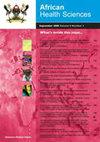Prevalence, severity, and correlates of erectile dysfunction among male adult patients of a primary care clinic in North-West Nigeria
IF 0.9
4区 医学
Q3 MEDICINE, GENERAL & INTERNAL
引用次数: 0
Abstract
Background: Erectile dysfunction (ED) is a common sexual problem that profoundly affects intimate relationships. It is poorly studied in North-western Nigeria. Objectives: To assess the prevalence, severity and predictors of ED among adult males attending a primary care clinic in Northwest Nigeria. Methods: A cross-section of 392 males (aged ≥25 years) were randomly selected from attendees of a family medicine clinic in Kano, Nigeria. Information regarding their biodata, lifestyle factors, and clinical characteristics was obtained using a structured questionnaire. The International Index of Erectile Function Questionnaire (version 5) and Patient Health Questionnaire-2 assessed ED and depression, respectively. Results: The participants' mean age was 45±14.1 years (range: 26-86 years). Most participants were married (88.8%), had one sexual partner (71.7%), had tertiary education (44.4%) and were traders (49.7%). The prevalence of ED was 52.3% (205/392) [comprising mild (36.0%), mild-to-moderate (14.3%), moderate (1.5%) and severe (0.5%)]. Age, body mass index (BMI), marital status, number of sexual partners, monthly income, type of exercise, hypertension history, blood pressure reading, antihypertensive and peptic ulcer drug use were associated with ED (P<0.05). However, age (≥50years) (OR= 1.91, 95%CI [1.28-2.85], P=0.001) and overweight/obesity (OR =1.81, 95%CI [1.18-2.77], P=0.007) were the predictors of ED in this population. Conclusion: ED prevalence was high, although mainly of the mild form. Age (≥50years) and overweight/obesity predicted ED. Hence, the need for early screening, objective grading of ED, identification of modifiable risk factors (e.g., overweight/obesity) and commencing proper treatment and prevention in this setting. Keywords: Correlates; erectile dysfunction; obesity; primary care; severity; Northwest Nigeria.尼日利亚西北部一家初级保健诊所成年男性患者勃起功能障碍的患病率、严重程度和相关因素
背景:勃起功能障碍(ED)是一种常见的性问题,严重影响亲密关系。尼日利亚西北部地区对这一问题的研究很少。 研究目的评估尼日利亚西北部一家初级保健诊所就诊的成年男性中勃起功能障碍的患病率、严重程度和预测因素。 方法从尼日利亚卡诺一家家庭医疗诊所的就诊者中随机抽取了 392 名男性(年龄≥25 岁)。通过结构化问卷调查获得了他们的生物数据、生活方式因素和临床特征等信息。国际勃起功能指数问卷(第 5 版)和患者健康问卷-2 分别对 ED 和抑郁症进行了评估。 结果:参与者的平均年龄为 45±14.1 岁(26-86 岁)。大多数参与者已婚(88.8%),有一个性伴侣(71.7%),受过高等教育(44.4%),是商人(49.7%)。ED 患病率为 52.3%(205/392)[包括轻度(36.0%)、轻度至中度(14.3%)、中度(1.5%)和重度(0.5%)]。年龄、体重指数(BMI)、婚姻状况、性伴侣数量、月收入、运动类型、高血压病史、血压读数、抗高血压药物和消化性溃疡药物的使用与 ED 相关(P<0.05)。然而,年龄(≥50 岁)(OR= 1.91,95%CI [1.28-2.85],P=0.001)和超重/肥胖(OR=1.81,95%CI [1.18-2.77],P=0.007)是该人群 ED 的预测因素。 结论ED 发病率很高,但主要是轻度 ED。年龄(≥50 岁)和超重/肥胖是预测 ED 的因素。因此,在这种情况下需要进行早期筛查、对 ED 进行客观分级、识别可改变的风险因素(如超重/肥胖)并开始适当的治疗和预防。 关键词:相关因素;勃起功能障碍相关因素;勃起功能障碍;肥胖;初级保健;严重程度;尼日利亚西北部。
本文章由计算机程序翻译,如有差异,请以英文原文为准。
求助全文
约1分钟内获得全文
求助全文
来源期刊

African Health Sciences
MEDICINE, GENERAL & INTERNAL-
CiteScore
2.30
自引率
0.00%
发文量
179
审稿时长
>12 weeks
期刊介绍:
The African Health Sciences is an internationally refereed journal publishing original articles on research, clinical practice, public health, policy, planning, implementation and evaluation, in the health and related sciences relevant to Africa and the tropics. Its objectives are to: Advocate for and promote the growth of reading culture in sub Saharan Africa; Provide a high quality journal in which health and policy and other researchers and practitioners in the region can and world wide, can publish their work; Promote relevant health system research and publication in the region including alternative means of health care financing, the burden of and solution of health problems in marginalized urban and rural communities amongst the displaced and others affected by conflict; Promote research and the systematic collection and collation and publication of data on diseases and conditions of equity and influence; Promote development of evidence-based policies and guidelines for clinical, public health and other practitioners. African Health Sciences acknowledges support provided by the African Health Journals Partnership Project that is funded by the US National Institutes of Health (through the National Library of Medicine and the Fogarty International Center) and facilitated by the Council of Science Editors.
 求助内容:
求助内容: 应助结果提醒方式:
应助结果提醒方式:


